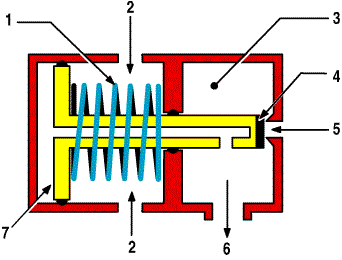|
Understanding SCUBA regulatorsBreathing underwater is like a dream come true. SCUBA regulators come in hundreds of designs and features. As we cover the different types of regulators, remember that the most important feature of a regulator is “ease of breathing”. At the highest level of scuba regulator design is Open-circuit or Closed-circuit regulator systems. Closed-circuit is what is commonly called re-breather regulators. A SCUBA diver’s exhalation is directed back into the scrubber to be re-cycled back into breathing the breathing air mixture. Open circuit scuba regulators allow the diver’s exhalation to be directed back into the water. Open-circuit or SCUBA regulators can be further defined into four main types: Diaphragm and Piston regulators and each can be balanced or unbalanced. Look at this diagram of an unbalanced piston regulator. Tank pressure influences the demand valve mechanism. This will make the regulator harder to breathe at lower tank pressures and/or difficult to breathe at deeper depths. Because of the piston regulator’s design, water pressure will enter the inside chamber, this can lead to extra cleaning during your annual maintenance.
2. Ambient water pressure
3. Intermediate chamber
4. Valve and HP seat assembly
5. HP air
6. Air to second stage
The balanced piston regulator isolates tank pressure from the demand valve. It is this isolation that allows the regulator to breathe easier through out the tank pressure ranges during the dive. Once the tank gets as low as 500 – 700 psi, even this regulator will begin to breathe with more difficultly.
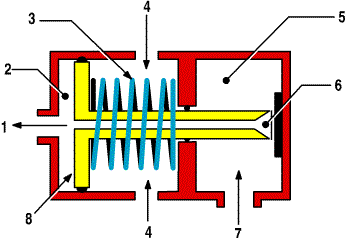
1. Air to second stage 2. Intermediate chamber 3. HP spring 4. Ambient water pressure 5. HP air chamber 6. Valve and HP seat assembly 7. HP air 8. Balanced piston assembly
Read more About Sherwood Balanced Piston Regulators
The unbalanced diaphragm regulator has been called the regulator that never was. It was built at one time, but today you will not see it on your local SCUBA stores shelves. This type of regulator uses an upstream valve design. Today’s regulators use a down stream valve technology. If an upstream valve regulator fails, it will stop delivering air to the diver. If a downstream valve regulator fails, you will still get air. Downstream valves have also been called a “fail safe” regulator design.
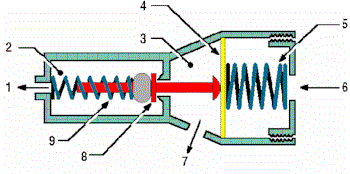
1. HP air 2. HP air chamber 3. Intermediate chamber 4. Diaphragm 5. Diaphragm balance spring 6. Ambient water pressure 7. Air to second stage 8. Valve & HP seat assembly 9. HP spring
The balanced diaphragm regulators also have more arts and are more complex than their piston counterparts. Since the diagram design also acts as an environmental seal, cold water divers prefer this design. This environmental seal is also preferred by divers working in contaminated and silty water.
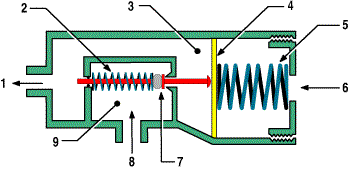
1. Air to second stage 2. Valve balance spring 3. Intermediate chamber 4. Diaphragm 5. Balance spring 6. Ambient water pressure 7. Valve & HP seat assembly 8. HP air 9. HP air chamber
Second stages (common to all regulators). When the diver inhales, the pressure drops and the diaphragm moves towards the low pressure of the second stage regulator, this in turn will move a valve which restores the pressure. When the diver exhales the diaphragm flexes outward and stops against the housing of the second stage regulator. Any excess air is shunted outward through one way valve positioned at the exhaust port.
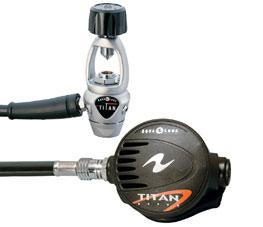
Return from scuba regulators back to our home page
|
